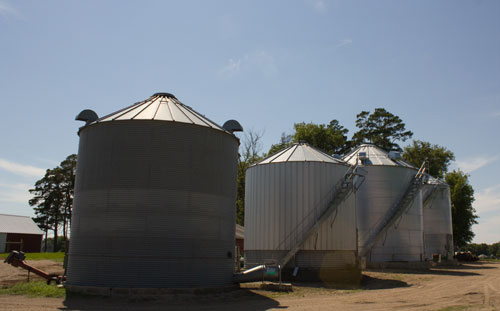
Grain entrapment is a farming hazard year-round; however, with all of the grain transport vehicles on the road and combines in the fields, it brings year-round safety to mind. As Penn State Extension reminds us, working with grain can provide a wide variety of safety risks, from electrical hazards of overhead power lines, portable augers, dryers and stirrers to increased potential for falls from ladders and other tall structures. This makes it a good time to remind all workers and family members to take safety precautions year-round in their daily work activities.
Let's focus on the grain entrapment. Most of the time I think of entrapment happening in grain bins specifically; however, grain transport vehicles such as gravity boxes and semi trailers also pose a risk. Penn State Extension's paper Hazards of Flowing Grain states that approximately 36 entrapments occur annually with over half of engulfment incidents resulting in a fatality. The three main causes of entrapment occur from:
- Flowing grain
- Collapse of a grain bridge
- Avalanche of a grain wall
The collapse of a grain bridge happens when moldy or hardened grain forms a crust. This poorly conditioned grain creates the "grain bridge." This bridge may be deceiving as you think it's solid under the crusty surface, but it actually may have a gap below where the grain is free flowing. This bridge can give way to the cavity below and again entrapment can occur quickly.
Lastly, the avalanche of a grain wall can occur if a worker is inside the bin and trying to break up a wall of grain. More grain than anticipated may fall down from the wall and 1 foot of grain over the entire individual would weigh approximately 300 pounds, too much weight for them to break free.
The risk is real for both grain bins and transport vehicles. If you enter any of these grain transport or storage structures, be sure to wear a full body harness and have multiple people on hand to assist if the situation takes a turn. Make sure you use extra safety precautions by turning off all augers that would move grain while someone is inside, make sure all workers are accounted for before you turn equipment and augers on, and be sure you're not alone.
Feel free to view the Penn State Extension paper, Hazards of Flowing Grain, for helpful diagrams and visuals that go along with this blog.

The author is the special publications editor, responsible for books, plans, distribution of the e-newsletter and various internal communication pieces. She grew up on a 60-cow dairy in northwest Wisconsin, and is a graduate of University of Wisconsin–Madison with a degree in life sciences communications.








